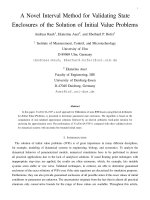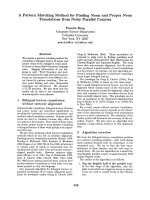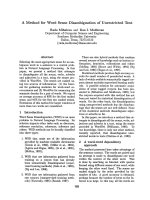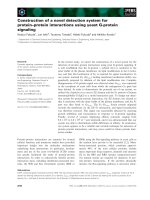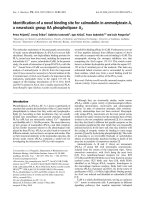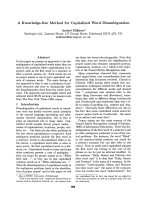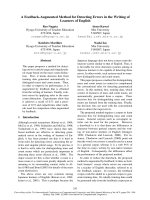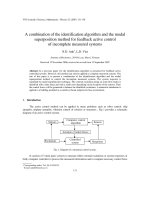A novel interval method for validating state enclosures of the
Bạn đang xem bản rút gọn của tài liệu. Xem và tải ngay bản đầy đủ của tài liệu tại đây (442.67 KB, 12 trang )
1
A Novel Interval Method for Validating State
Enclosures of the Solution of Initial Value Problems
Andreas Rauh
1
, Ekaterina Auer
2
, and Eberhard P. Hofer
1
1
Institute of Measurement, Control, and Microtechnology
University of Ulm
D-89069 Ulm, Germany
{Andreas.Rauh, Eberhard.hofer}@uni-ulm.de
2
Ekaterina Auer
Faculty of Engineering, IIIS
University of Duisburg-Essen
D-47048 Duisburg, Germany
Abstract
In this paper, VALENCIA-IVP, a novel approach for VALidation of state ENClosures using Interval Arithmetic
for Initial Value Problems, is presented to determine guaranteed state enclosures. The algorithm is based on the
computation of non-validated approximate solutions followed by an interval arithmetic fixed-point iteration for
enclosing the approximation error. The performance of VALENCIA-IVP is compared with other validated solvers
for dynamical systems with uncertain but bounded initial states.
I. INTRODUCTION
The solution of initial value problems (IVPs) is of great importance in many different disciplines,
for example, modeling of dynamical systems in engineering, biology, and economics. To analyze the
dynamical behavior of parameterized models, numerical simulations have to be performed in almost
all practical applications due to the lack of analytical solutions. If usual floating point techniques with
inappropriate step-sizes are applied, the results are often erroneous, which, for example, lets instable
systems seem stable or vice versa. Validated techniques, in contrast, are able to determine guaranteed
enclosures of the exact solutions of IVPs even if the state equations are discretized for simulation purposes.
Furthermore, they can also provide guaranteed enclosures of all possible states if the exact values of initial
conditions or parameters are unknown. The uncertainties originate from the fact that in almost all practical
situations only conservative bounds for the range of these values are available. Throughout this article,
2
the words validated, guaranteed, and verified are used interchangeably to denote that state enclosures are
mathematically and not only empirically proven to be correct.
Traditional validated techniques for the solution of IVPs are implemented in various software pack-
ages. VNODE [1], [2] and COSY VI [3], [4] are probably two of the most representative tools, see
Subsection II-C. Although they are fairly efficient for exactly known initial states and parameters, they
are sometimes insufficient for practical scenarios with uncertain but bounded initial states and parameters
which have to be considered in verification and design of robust control strategies for sensitivity analysis
of the system w.r.t. all uncertainties. These uncertainties often lead to increased overestimation due to the
wrapping effect and the dependency problem and therefore in many cases to higher computational effort
for its reduction.
In this article, a new algorithm implemented in the solver VALENCIA-IVP
1
is proposed. First, an
approximate solution of an IVP similar to the considered one is calculated with exactly known initial
states and parameters. Based on this approximate solution, an easy-to-implement fixed-point iteration
scheme is derived to determine validated enclosures by evaluation of the set of state equations on a finite
time interval. It is shown for two examples that these state enclosures are tighter than those of VNODE
and comparable to COSY VI with a significant reduction of CPU time in the latter case.
In Sections II and III, a problem formulation is given, the new method is introduced, and the proof
is presented that all reachable states are guaranteed to be enclosed by the obtained interval bounds.
Additionally, possible applications in control engineering, especially for design and analysis of robust
controllers, are pointed out. A detailed overview of VALENCIA-IVP is given in Section IV. In Section V,
VALENCIA-IVP is applied to two different systems with nominal system parameters and uncertain initial
conditions to compute verified enclosures of all reachable states. The results are compared to methods
implemented in VNODE and COSY VI with respect to the necessary computational effort, the achievable
simulation times, and the widths of the resulting interval bounds. Finally, an outlook on future research
is given in Section VI.
II. PROBLEM FORMULATION
A. Considered Initial Value Problems
In this paper, initial value problems for nonlinear ordinary differential equations (ODEs)
˙x
s
(t) = f
s
(x
s
(t) , p(t),t) (1)
with the initial values x
s
(t
0
) ∈
x
0
s
, where t
0
= 0 without loss of generality, are studied. These ODEs
are assumed to be given in state space representation with the state vector x
s
∈ R
n
s
and the parameter
vector p ∈ R
n
p
. To apply VALENCIA-IVP, existence and continuity of the first derivatives of f
s
with
respect to all states, parameters, and the time variable t is required, i.e., f
s
: D → R
n
s
, D ⊂ R
n
s
×R
n
p
×R
1
open, f
s
∈ C
1
(D, R
n
s
). Interval uncertainties of the initial states are denoted by the interval
x
0
s
=
x
0
s
; x
0
s
and parameter uncertainties by [p (t)] =
p(t) ; p (t)
, resp. The dynamics of time-varying parameters is
1
Further information about ValEncIA-IVP as well as free software are available at .
3
assumed to be given in state space representation ˙p(t) = ∆p (t), where both p(t) and ∆p(t) are bounded.
If the variation rates of these parameters are unknown, the interval bounds ∆p (t) and ∆p (t) are infinite.
Since the dynamical models for ˙x
s
(t) and ˙p(t) can be combined in a single set of ODEs
˙x (t) = f (x(t) ,t) =
f
s
(x
s
(t) , p (t),t)
∆p (t)
(2)
with the extended state vector x(t) =
x
T
s
(t) ; p
T
(t)
T
∈ R
n
, n = n
s
+ n
p
, discussion is restricted to the
case of uncertain initial states to present the solver VALENCIA-IVP. It aims at calculating tight enclosures
[x
encl
(t)] for the unknown exact range [x (t)] of all reachable states for t ≥ 0 under consideration of all
above-mentioned uncertainties.
The dynamical systems may be explicitly time-varying as denoted by the dependency on the time
variable t in the state equations (1) and (2). Typical applications of time-varying systems are switchings
between different control strategies, e.g. for the transient behavior after setting a system into operation,
for control near steady state operating conditions, and for shut down. Often, switching points themselves
are state-dependent and unknown a priori. Thus, the assumption of continuous differentiability of the
state equations might be violated. Therefore, only systems with a finite number of switching points are
usually considered. Then, integration of the IVP can be stopped at the switching point and restarted with
the system model valid afterwards. General techniques for state-dependent switchings between dynamical
models where this cannot be done easily are studied in [5]–[7] and the references therein.
B. Validated Enclosures of Initial Value Problems in Control Engineering
Important applications of validated techniques for IVPs in control engineering are analysis and design
of robust, optimal, and adaptive controllers. For nonlinear systems, robustness analysis with respect
to uncertain initial states and parameters can be performed by calculating enclosures of all reachable
states. These results have to be compared with time-domain specifications of the desired system behavior
expressing all limitations of state variables, especially if the dynamical behavior of safety-critical systems
is analyzed.
On the one hand, for a given controller with fixed parameters, validated simulations can prove if
violation of these bounds is impossible for interval uncertainties. On the other hand, these techniques
are also applied successfully in the design of control strategies. First, if a controller structure is already
specified, its parameters can be chosen such that all states of the closed-loop system are guaranteed to
be within predefined bounds. Second, if the controller structure is not given, it is possible to determine
optimal controllers by minimization of performance indices. This problem can be extended by simultaneous
consideration of time-domain robustness specifications. Third, evaluation and design of adaptive controllers
can be carried out by sensitivity analysis of the system dynamics with respect to variations of the controller
parameters. Forth, validated simulation techniques cannot only be applied to determine suitable controllers.
They also allow for detection of cases in which admissible control strategies do not exist.
The above-mentioned typical scenarios demonstrate the necessity for study and development of validated
methods for both verification and design of modern control strategies.
4
C. Validated Techniques for the Solution of Initial Value Problems: VNODE and COSY VI
In recent years, various verification techniques for the solution of IVPs relying on defect-based meth-
ods [8], [9], Taylor series expansions (VNODE), or Taylor models (COSY VI) have been developed.
The main difference between VALENCIA-IVP and defect-based methods as well as methods relying
on Taylor series expansions is that only the first derivatives of the ODEs with respect to the states,
parameters, and time are required for reduction of overestimation by mean-value rule evaluation and other
advanced interval methods such as monotonicity tests and iterative techniques for range calculation. In
contrast to the VALENCIA-IVP solver, VNODE is based on a two stage approach. First, a proof of
existence and uniqueness of the solution of the IVP is performed by calculation of guaranteed a priori
enclosures of all reachable states in the time interval between two subsequent discretization steps by a
Picard iteration. Second, an interval Taylor series or the interval Hermite-Obreschkoff method is applied
to compute enclosures from the result of the preceding time step and an additive correction term including
all discretization errors. The applicable step-sizes are basically restricted by the convergence of the Picard
iteration. Since naive implementation leads to considerable overestimation in most cases, non-orthogonal
(parallelepiped) or orthogonal (QR factorization) coordinate transformations are used to obtain tighter
enclosures [10]. Growth of the computed interval diameters over simulation time is inevitable as long as
only explicit integration techniques are applied.
In the Taylor model-based ODE solver COSY VI, Taylor expansion of the solution in time and initial
conditions is performed to reduce the influence of overestimation by modeling the local functional behavior
and control of the long-term growth of integration errors [3]. The arithmetic based on Taylor models —
implemented in the package COSY INFINITY — relies on high order polynomial approximations to
a Taylor series with floating point polynomial coefficients and interval remainder terms [4], [11], [12].
COSY VI uses the Picard iteration in combination with the Schauder fixed-point theorem and iterative
refinement of the inclusions to obtain a Taylor model of the exact solution [13].
To control long-term growth of integration errors the shrink wrapping method — a modified nonlinear
version of the parallelepiped method — is applied. In the present version of COSY VI, QR-based, blunting,
and curvilinear preconditioning of Taylor models are implemented to improve the long-term performance.
Moreover, different orders of the expansions in initial conditions and time can be chosen to reduce
the computational effort. For appropriate orders and step-sizes, overestimation is reduced significantly.
However, the main drawback of this solver can often be long computation time for systems with many
state variables.
III. ITERATION SCHEME OF VALENCIA-IVP
Most interval techniques to enclose the solution of IVPs rely on integration of a set of ODEs on a finite
time interval [0 ; T ] according to
x (t) = x(0)+
t
0
f (x (τ) , τ)dτ with t ∈ [0 ; T ] . (3)
5
Since x (t) is the desired, and thus except for
x
0
x (0) unknown solution of the IVP on the time interval
[0 ; T ], the integral in (3) is replaced by a conservative approximation
t
0
f (x (τ) , τ)dτ ⊆ [0 ; t] · f ([B] , [0 ; t]) , (4)
where [B] is a bounding box enclosing all reachable states in the time interval [0 ; t]. This bounding box
can be computed by the Picard iteration
B
(κ+1)
=
x
0
+ [0 ; t] · f
B
(κ)
, [0 ; t]
, (5)
which is initialized with
B
(0)
=
x
0
. If the complete time interval is considered as a special case, t is
replaced by T in (5). The interval of the initial guess for
B
(0)
is widened as long as
B
(1)
⊆
B
(0)
. If
B
(1)
⊆
B
(0)
, (5) is evaluated recursively until
B
(κ+1)
≈
B
(κ)
. If this algorithm does not converge
or if the resulting bounding box is unacceptably large, the width of the considered time interval has to
be reduced [14]. Such bounding boxes are used in VNODE and other solvers as rough a priori state
enclosures in the first stage of the algorithm — partially in a modified form of Taylor series-based bounds
instead of the right side of (4).
In VALENCIA-IVP, the bounding box [B] is no longer assumed to be constant as in the above-mentioned
basic idea. It is replaced by the time-varying state enclosure
[x
encl
(t)] = x
app
(t) +[R(t)] , (6)
where x
app
(t) is an approximate solution of the IVP and [R(t)] the interval enclosure of the unknown
error terms. Substituting the enclosure [x
encl
(t)] for [B] in (5) and differentiating with respect to time on
both sides of (5) as well as solving for
˙
R(t)
leads to the iteration formula
˙
R
(κ+1)
(t)
= − ˙x
app
(t) + f
x
app
(t) +
R
(κ)
(t)
,t
= − ˙x
app
(t) + f
x
(κ)
encl
(t)
,t
. (7)
Here, the integrand in (4) has been used to replace the time derivative on the right hand side. Analogously
to the Picard iteration (5), this expression can again be evaluated for the complete time interval [0 ; T ].
In each iteration step κ the enclosure
R
(κ+1)
(t)
⊆
R
(κ+1)
(0)
+
t
0
˙
R
(κ+1)
(τ)
dτ or
R
(κ+1)
(t)
⊆
R
(κ+1)
(0)
+t ·
˙
R
(κ+1)
([0 ; t])
, 0 ≤ t ≤ T
(8)
of the approximation error is determined by verified integration of the bounds for
˙
R
(κ+1)
(t)
with respect
to time until
˙
R
(κ+1)
(t)
≈
˙
R
(κ)
(t)
and therefore also
R
(κ+1)
(t)
≈
R
(κ)
(t)
. According to Banach’s
fixed-point theorem, the approach converges to a verified enclosure of the IVP if
˙
R
(κ+1)
(t)
⊆
˙
R
(κ)
(t)
and therefore also
R
(κ+1)
(t)
⊆
R
(κ)
(t)
.
To summarize, VALENCIA-IVP is based on a fixed-point iteration to calculate enclosures of
˙
R(t)
directly by repeated evaluation of (7). The enclosure
x
(κ+1)
encl
(t)
is re-evaluated after each improvement
6
of the error bounds
R
(κ+1)
(t)
. Note that neither separate calculation of bounds for time discretization
errors nor series expansion of the solution of the IVP are necessary. The quality of the state enclosures
depends on the initial approximation x
app
(t). Smaller deviations between the unknown exact solution and
its initial approximation lead to smaller interval widths for
˙
R(t)
, see the following Section.
IV. ALGORITHM
In this Section, the key components of VALENCIA-IVP are discussed in detail.
Step 1: Calculation of Reference Solutions In a first step, an appropriate reference solution is determined
either analytically or numerically. To obtain an initial approximation for the analytical reference solution
a set of linear ODEs
˙x
app
(t) = f
lin
(x
app
(t)) (9)
with the same dimension as the original system is solved analytically for x
0
app
= x
app
(0) =
1
2
x
0
+ x
0
.
Usually, the original state equations are linearized in a typical operating point or nonlinear terms are
replaced or neglected for this purpose. One possible way to improve the analytical reference solution
x
app
(t) is the perturbation approach
˙x (t) = (1 − ε)· f
lin
(x (t)) + ε · f (x (t) ,t) = f
ε
(x (t),t, ε) with ε ∈ [0 ; 1] . (10)
The perturbed system f
ε
is linear for ε = 0 and equal to the original nonlinear system for ε = 1 [15]. For
appropriately chosen but yet unknown error bounds [R (t)] ∈ R
n
, the solution of the initial value problem
and its time derivative are enclosed by
[x
encl
(t)] =
m
∑
j=0
ε
j
y
app, j
(t)
+ [R (t)] = x
app
(t) +[R(t)] and
[ ˙x
encl
(t)] =
m
∑
j=0
ε
j
˙y
app, j
(t)
+
˙
R(t)
= ˙x
app
(t) +
˙
R(t)
(11)
with unknown functions y
app, j
(t) ∈ R
n
, j = 0, . ,m. The vectors x(t) and ˙x (t) in (10) are replaced by
[x
encl
(t)] and [ ˙x
encl
(t)] as defined in (11). Setting [R (t)] and
˙
R(t)
to zero and sorting for identical powers
of ε on both sides of the expression, a set of ODEs for y
app, j
(t) with the dimension m · n is obtained
after setting the coefficients of ε
j
on the left hand side equal to the corresponding coefficients on the
right hand side. This set of ODEs is solved analytically — again after linearization or replacement of
nonlinear terms — for the initial conditions y
0
app,0
= x
0
app
and y
0
app, j
= 0, ∀ j ≥ 1. Now, the iteration (7)
is performed with the improved approximation x
app
(t) for ε = 1 which is demonstrated for the simple
pendulum example in Subsection V-A.
Alternatively, numerical approximations
x
N
i
, i = 0, . , L, for the original IVP with point intervals
x
N
0
= mid
x
0
as initial conditions can be calculated over the grid
{
t
i
}
with t
L
= T by arbitrary non-
validated IVP solvers. To apply the iteration scheme (7), analytical approximations x
app
(t) and ˙x
app
(t)
are computed by minimization of the distance measure
D =
L
∑
i=1
d
x
N
i
− x
app
(t
i
)
e.g.
=
L
∑
i=1
x
N
i
− x
app
(t
i
)
2
2
. (12)
7
As demonstrated in Subsection V-B, already linear interpolations
x
app
(t) = x
N
i
+
x
N
i+1
− x
N
i
t
i+1
−t
i
· (t −t
i
) with
˙x
app
(t) =
x
N
i+1
− x
N
i
t
i+1
−t
i
for t ∈ [t
i
; t
i+1
], i = 0, . , L −1
(13)
lead to good results. Further improvement of the approximate solutions is possible by higher-order
approximations. However, for interval arguments overestimation in evaluation of (7) is increasing due to
the nonlinearity of higher-order approximations leading to higher computational effort for overestimation
reduction in Step 3 and Step 4.
Step 2: Initialization of the Iteration Scheme To start the iteration (7), initial interval approximations for
[R(t)] and
˙
R(t)
are required. If possible, nonlinear terms in the state equation (2) are replaced by rough
but conservative bounds, e.g. sin(·) and cos(·) by the interval [−1 ; 1]. Afterwards,
˙
R
(1)
(t)
is calculated
for κ = 0. The iteration is continued, if
˙
R
(1)
(t)
⊆
˙
R
(0)
(t)
. Otherwise the initial guess for [R (t)] and
˙
R(t)
has to be modified. Note that [R (0)] always has to be chosen such that
x
0
⊆ x
app
(0) + [R (0)].
Step 3: Subdivision of the Time Span into Several Time Intervals If the time span [0 ; T ] is split into
several intervals [t
i
; t
i+1
] to improve convergence of the iteration and to reduce the width of the error
bounds, the validated integration (8) is replaced by
R
(κ+1)
(t
i+1
)
=
R
(κ+1)
(0)
+
i
∑
j=0
t
j+1
−t
j
·
˙
R
(κ+1)
t
j
; t
j+1
. (14)
Step 4: Calculation of the State Enclosures The width of the resulting state enclosures [x (t)] ⊆ x
app
(t) +
[R(t)] can be reduced by improved initial approximations in Step 1 as well as shorter time intervals in
Step 3. Overestimation due to multiple occurrence of identical interval variables in (7) is reduced by
mean-value rule evaluation as well as efficiently implemented iterative improvement of the range of the
expression on the right hand side including monotonicity tests [16]–[18].
V. SIMULATION RESULTS
In this Section, the applicability of VALENCIA-IVP is demonstrated for two examples. First, a simple
pendulum is used to demonstrate the basics of the proposed algorithm, the dependency of the simulation
results on the quality of the initial approximation, and the perturbation approach for calculation of ana-
lytical reference solutions. Second, VALENCIA-IVP is compared in detail with VNODE and COSY VI
for a double pendulum with uncertain initial conditions.
A. Simple Pendulum
The simple pendulum described by the nonlinear state equations
˙
φ
1
(t)
˙
φ
2
(t)
=
φ
2
(t)
−sin(φ
1
(t))
= f (φ (t)) , φ (t) =
φ
1
(t)
φ
2
(t)
=
θ
1
(t)
˙
θ
1
(t)
(15)
with exactly known initial conditions φ
1
(0) = φ
0
1
and φ
2
(0) = φ
0
2
is considered, see Fig. 1.
8
m
2
m
1
l
2
θ
2
x
l
1
θ
2
y
y
m1
y
m2
x
m1
x
m2
x
m1
= l
1
sin(θ
1
)
x
m2
= −l
1
cos(θ
1
)
y
m2
= −l
1
cos(θ
1
) −l
2
cos(θ
2
)
y
m1
= l
1
sin(θ
1
) +l
2
sin(θ
2
)
θ
1
= θ
1
Figure 1: Definition of state variables for simple pendulum (boldface, black) and double pendulum (grey).
Applying the perturbation approach (Section IV, Step 1) to determine approximations of the desired
solution with f
lin
(φ (t)) =
φ
2
(t) −φ
1
(t)
T
leads to
[ f
ε
] =
m
∑
j=0
ε
j
˙y
app, j
(t)
+
˙
R(t)
=
m
∑
j=0
ε
j
y
app,2, j
(t)
+ [R
2
(t)]
−(1− ε)
m
∑
j=0
ε
j
y
app,1, j
(t)
+ [R
1
(t)]
+
0
−ε sin
m
∑
j=0
ε
j
y
app,1, j
(t)
+ [R
1
(t)]
.
(16)
Case 1: Considering only terms with ε
0
and neglecting the error term [R(t)] yields
˙y
app,1,0
(t) = y
app,2,0
(t) , ˙y
app,2,0
(t) = −y
app,1,0
(t) (17)
which is solved analytically for y
0
app,1,0
= φ
0
1
= 1 and y
0
app,2,0
= φ
0
2
= 0. The solution
y
app,1,0
(t) = cos(t), y
app,2,0
(t) = −sin(t) (18)
is represented by dotted lines in Fig. 2.
Case 2: If terms with ε
1
as well as trigonometric terms are taken into account according to
˙y
app,1,0
(t) = y
app,2,0
(t)
˙y
app,2,0
(t) = −y
app,1,0
(t)
˙y
app,1,1
(t) = y
app,2,1
(t)
˙y
app,2,1
(t) = −y
app,1,1
(t) +y
app,1,0
(t) −sin
y
app,1,0
(t)
(19)
the corresponding solution is given by
y
app,1,0
(t) = cos(t)
y
app,2,0
(t) = −sin(t)
y
app,1,1
(t) =
−
1
2
− cos(1)
cos(t) +
1
2
cos
3
(t) +cos(t)cos(cos(t)) − sin(t) I (t)
y
app,2,1
(t) =
1
2
sin(t)
(1 + 2cos(1)) − cos
2
(t) −2cos (cos(t))
− cos(t)I (t)
(20)
9
with
I (t) =
t
0
cos(τ)[−cos(τ) +sin(cos(τ))]dτ (21)
and the initial conditions y
0
app,1,0
= φ
0
1
= 1, y
0
app,2,0
= φ
0
2
= 0, y
0
app,1,1
= 0, and y
0
app,2,1
= 0. The iteration
formula (7) is now evaluated for
x
app
(t) =
m
∑
j=0
y
app,1, j
(t)
y
app,2, j
(t)
, (22)
where m = 0 for Case 1 and m = 1 for Case 2. The interval enclosures for all state variables and the initial
approximations x
app,1
(t) and x
app,2
(t) are shown in Fig. 2. In the considered time span, the improved
initial approximation in Case 2 leads to tighter enclosures of the solution of the original IVP. Both
results have been computed over identical equally spaced grids on the time axis with t
i+1
−t
i
= 1·10
−3
,
i = 0, . , L − 1, in Step 3, Section IV. The term I (t) is replaced by a verified interval enclosure. In all
computations floating point values which are not exactly representable by machine numbers are replaced
by their smallest possible interval enclosures.
initial approx. (case 2)
initial approx. (case 1)
−2
100 2 4 6 8
0
1
2
−1
t
φ
1
(a) Enclosure of the first state variable.
initial approx. (case 1)
initial approx. (case 2)
−2
100 2 4 6 8
0
1
2
−1
t
φ
2
(b) Enclosure of the second state variable.
Figure 2: Interval enclosures for the state variables of the simple pendulum (solid lines for Case 1 and dashed lines for Case 2)
together with both initial approximations.
B. Double Pendulum with Uncertain Initial States
In this Subsection, VALENCIA-IVP is compared with validated techniques from VNODE and COSY VI
for a double pendulum with an uncertain initial angle of the first joint, see Fig. 1. To derive the state
equations, two weightless arms with lengths l
1
and l
2
as well as two point masses m
1
and m
2
under
influence of the gravitational constant g are given. Using the Lagrangian formulation with the coordinates
of the mass points as defined in Fig. 1 and the state vector φ (t) =
θ
1
(t) θ
2
(t)
˙
θ
1
(t)
˙
θ
2
(t)
T
of
angles and angular velocities leads to
˙
φ (t) = M
−1
(φ (t)) ·F (φ (t)) , (23)
10
with
M (φ (t)) =
1 0 0 0
0 1 0 0
0 0 (m
1
+ m
2
)l
1
m
2
l
2
cos(φ
1
− φ
2
)
0 0 m
2
l
1
cos(φ
1
− φ
2
) m
2
l
2
(24)
and
F (φ (t)) =
φ
3
φ
4
−g(m
1
+ m
2
)sin(φ
1
) − m
2
l
2
sin(φ
1
− φ
2
)φ
2
4
−gm
2
sin(φ
2
) + m
2
l
1
sin(φ
1
− φ
2
)φ
2
3
. (25)
With the substitutions θ
1
(t) = θ
1
(t) and θ
2
(t) = θ
1
(t) + θ
2
(t) introduced in Fig. 1 the state vector
ψ (t) =
θ
1
(t) θ
2
(t)
˙
θ
1
(t)
˙
θ
2
(t)
T
=
φ
1
φ
2
− φ
1
φ
3
φ
4
− φ
3
T
is defined according to the Denavit-
Hartenberg conventions which are often used in analysis of complex mechanical manipulators.
Simulations for the parameters l
1
= l
2
= 1, m
1
= m
2
= 1, and g = 9.81 as well as the uncertain initial
conditions ψ
0
=
0.99
3π
4
−
11π
20
0.43 0.67
T
,
ψ
0
=
1.01
3π
4
−
11π
20
0.43 0.67
T
are performed with
VALENCIA-IVP, VNODE, and COSY VI. For VALENCIA-IVP, linear interpolation of a non-validated
initial approximation
x
N
i
, i = 1, . , L, determined by the MATLAB solver ode45s has been used
with an equally spaced grid
{
t
i
}
, t
i
− t
i−1
= 5·10
−4
. Mean-value rule (MVR) evaluation and advanced
interval methods (AIM) have been applied to evaluate the iteration formula (7), see Step 4, Section IV. In
VNODE, an interval Taylor series method with QR factorization has been employed while for COSY VI
the QR preconditioning has been chosen, both with a Taylor series expansion of order 12 (in COSY VI
for both time and initial states) and constant step-sizes. Shrink wrapping could not improve the simulation
quality.
VNODE
COSY VI
(AIM)
VALENCIA-IVP
−1
1.00 0.2 0.4 0.6 0.8
t
ψ
1
0
1
2
3
Figure 3: Validated interval bounds for the first state variable of the double pendulum, see also Tab. I.
In Tab. I and Fig. 3 representative results for these solvers are shown. For each a compromise between
achievable break-down times and required computational times has been made. VALENCIA-IVP computes
tighter enclosures than the interval Taylor series method in VNODE. Similar results are also observed
for the interval Hermite-Obreschkoff method in VNODE. In Tab. I, the widths of the enclosures are
11
VNODE COSY VI VALENCIA-IVP
step-size 0.002 step-size 0.002 MVR AIM
Break-down time 0.5221 0.6300 0.5705 >1.0
Relative reduction factor at t = 0.5 1.0 1.50·10
4
2.76·10
2
2.97·10
3
Computing time over [0;0.5]
15.4 s 1 hrs 6 min 360 s (1) 1 hrs 38 min (1)
(Intel Pentium IV, 3.0 GHz, 1 GB RAM, CYGWIN) 12 s (2) 94 s (2)
Table I: Comparison of results for the double pendulum: (1) MATLAB 7 SP3, (2) C++ implementation.
VNODE COSY VI
step-size break-down time CPU time over [0;0.5] break-down time CPU time over [0;0.5]
0.02 0.4818 — 0.3800 —
0.002 0.5221 15.4 s 0.6300 1 hrs 6 min
0.0002
0.5284 152 s 0.6300 8 hrs 37 min
Table II: Comparison of results for the double pendulum (cont’d).
compared by the ratio between the pseudo volume (product of the interval diameters of all components
of a state vector) of VNODE and the pseudo volume of all other enclosures at t = 0.5. The comparison
of computing times only gives a rough idea about the efficiency of the three methods since they are all
implemented differently. For VALENCIA-IVP, a MATLAB implementation using INTLAB 5.2 [19], [20]
as well as a prototypical C++ implementation using PROFIL/ BIAS [21] and FADBAD [22] are compared.
Reducing the step-size as well as increasing the order of the Taylor series expansion in VNODE do not
affect the simulation quality significantly. Increasing the order of the series expansions in COSY VI for
relatively large step-sizes also has minor influence; smaller step-sizes lead to break-down times t > 2 with
much higher CPU times than those of VALENCIA-IVP, see Tab. II.
VI. CONCLUSIONS AND OUTLOOK ON FUTURE RESEARCH
In this paper, VALENCIA-IVP has been introduced as a novel approach for validation of state enclosures
for initial value problems with both uncertain initial conditions and tolerances in the system parameters.
Although it has been shown that the required computational times of the new algorithm are comparable
to other techniques, tighter state enclosures have been obtained.
Further improvement by preconditioning of the state equations as well as combination with advanced
simulation techniques which employ splitting and merging strategies of subintervals for improved en-
closures of complexly shaped regions of reachability in the state space are of interest. Since these
enhancements are quite general ideas, they can be employed for various enclosure methods, i.e., not
only for VALENCIA-IVP but also for methods like those from VNODE or COSY VI. Consistency tests
which are based on backward integration of subintervals of validated enclosures to reduce overestimation
can be applied to tighten interval bounds efficiently [14] and to prevent growth of the computed interval
enclosures over simulation time.
Sophisticated techniques for selection of the widths of subintervals on the time axis and optimization of
the C++ implementation of VALENCIA-IVP are only two further possibilities for performance improve-
ment. From an engineering point of view, application of VALENCIA-IVP to sensitivity and reliability
12
analysis as well as robust and optimal controller design [23] are interesting topics for future research.
Additionally, validated solutions of initial value problems with uncertainties are of great importance in
adaptive and predictive control as well as in the design of nonlinear model based observers.
REFERENCES
[1] N. S. Nedialkov, “Computing Rigorous Bounds on the Solution of an Initial Value Problem for an Ordinary Differential Equation,”
Ph.D. dissertation, University of Toronto, 1999.
[2] ——, The Design and Implementation of an Object-Oriented Validated ODE Solver. Kluwer Academic Publishers, 2002.
[3] K. Makino and M. Berz, “Suppression of the Wrapping Effect by Taylor Model-Based Validated Integrators,” Michigan State University,
Tech. Rep. MSU HEP 40910, 2004.
[4] N. Revol, K. Makino, and M. Berz, “Taylor Models and Floating-Point Arithmetic: Proof that Arithmetic Operations are Validated in
COSY,” Journal of Logic and Algebraic Programming, vol. 64, pp. 135–154, 2005.
[5] A. Rauh, M. Kletting, H. Aschemann, and E. P. Hofer, “Interval Methods for Simulation of Dynamical Systems with State-Dependent
Switching Characteristics,” in Proc. of the IEEE International Conference on Control Applications CCA 2006, Munich, Germany, 2006,
pp. 2243–2248.
[6] R. Rihm, “Über Einschließungsverfahren für gewöhnliche Anfangswertprobleme und ihre Anwendung auf Differentialgleichungen mit
unstetiger rechter Seite (in German),” Ph.D. dissertation, University of Karlsruhe, Germany, 1993.
[7] N. S. Nedialkov and M. v. Mohrenschildt, “Rigorous Simulation of Hybrid Dynamic Systems with Symbolic and Interval Methods,”
in Proc. of American Control Conference ACC, Anchorage, USA, 2002, pp. 140–147.
[8] W. Kühn, “Rigorous Error Bounds for the Initial Value Problem Based on Defect Estimation,” Tech. Rep., 1999,
/>[9] R. Rihm, “Interval Methods for Initial Value Problems in ODEs,” in Topics in Validated Computations, J. Herzberger, Ed. Elsevier
Science, 1994, pp. 173–207.
[10] R. Lohner, “On the Ubiquity of the Wrapping Effect in the Computation of the Error Bounds,” in Perspectives on Enclosure Methods,
U. Kulisch, R. Lohner, and A. Facius, Eds. Springer, Wien, New York, 2001, pp. 201–217.
[11] M. Berz and K. Makino, “COSY INFINITY Version 8.1. User’s Guide and Reference Manual,” Michigan State University, Tech. Rep.
MSU HEP 20704, 2002.
[12] A. Neumaier, “Taylor Forms — Use and Limits,” Reliable Computing, vol. 9, pp. 43–79, 2002.
[13] M. Berz and K. Makino, “Verified Integration of ODEs and Flows Using Differential Algebraic Methods on High-Order Taylor Models,”
Reliable Computing, vol. 4, pp. 361–369, 1998.
[14] Y. Deville, M. Janssen, and P. van Hentenryck, “Consistency Techniques for Ordinary Differential Equations,” Constraint, vol. 7, no.
3–4, pp. 289–315, 2002.
[15] H. K. Khalil, Nonlinear Systems, 3rd ed. Prentice Hall, 2002.
[16] A. Rauh, M. Kletting, H. Aschemann, and E. P. Hofer, “Application of Interval Arithmetic Simulation Techniques to Wastewater
Treatment Processes,” in Proc. of Modelling, Identification, and Control MIC, Grindelwald, Switzerland, 2004, pp. 287–293.
[17] I. Krasnochtanova, “Optimized Interval Algorithms for Simulation and Controller Design for Nonlinear Uncertain Systems Applied to
Processes in Biological Wastewater Treatment,” Master Thesis, University of Ulm, 2005.
[18] E. Auer, A. Rauh, E. P. Hofer, and W. Luther, “Validated Modeling of Mechanical Systems with SMARTMOBILE : Improvement of
Performance by VALENCIA-IVP,” in Proc. of Dagstuhl Seminar 06021: Reliable Implementation of Real Number Algorithms: Theory
and Practice, Lecture Notes in Computer Science, Dagstuhl, Germany, 2006, in print.
[19] S. M. Rump, “INTLAB — INTerval LABoratory,” in Developments in Reliable Computing, T. Csendes, Ed. Kluver Academic
Publishers, 1999, pp. 77–104.
[20] ——, “Interval Computations with INTLAB,” Brazilian Electronic Journal on Mathematics of Computation, vol. 1, 1999.
[21] O. Knüppel, “PROFIL/BIAS—A Fast Interval Library,” Computing, vol. 53, pp. 277–287, 1994.
[22] C. Bendsten and O. Stauning, “FADBAD, a Flexible C++ Package for Automatic Differentiation Using the Forward and Backward
Methods,” Technical University of Denmark, Lyngby, Tech. Rep. 1996-x5-94, 1996.
[23] A. Rauh and E. P. Hofer, “Interval Arithmetic Optimization Techniques for Uncertain Discrete-Time Systems,” in Proc. of 13th
Int. Workshop on Dynamics and Control, Wiesensteig, Germany, 2005, pp. 141–148.

